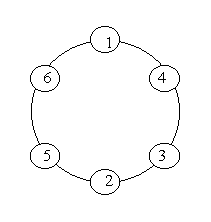Problem Description
A ring is compose of n circles as shown in diagram. Put natural number 1, 2, ..., n into each circle separately, and the sum of numbers in two adjacent circles should be a prime.
Note: the number of first circle should always be 1.

Note: the number of first circle should always be 1.

Input
n (0 < n < 20).
Output
The output format is shown as sample below. Each row represents a series of circle numbers in the ring beginning from 1 clockwisely and anticlockwisely. The order of numbers must satisfy the above requirements. Print solutions in lexicographical order.
You are to write a program that completes above process.
Print a blank line after each case.
You are to write a program that completes above process.
Print a blank line after each case.
Sample Input
6 8
Sample Output
Case 1: 1 4 3 2 5 6 1 6 5 2 3 4 Case 2: 1 2 3 8 5 6 7 4 1 2 5 8 3 4 7 6 1 4 7 6 5 8 3 2 1 6 7 4 3 8 5 2
本题就是考递归搜索的能力。
数据不大,其他Prime, map等的优化都没多大作用的。
记得记录好数据,就不会有问题了。
不过HDU的判断系统的确垃圾,其他OJ都不会在意末尾多一个空格或者回车的问题的,HDU就一个空格一个回车都一定要按照她的格式,否则就presentation error.
#include <stdio.h>
const int MAX_N = 20;
int num;
int cycle[MAX_N];
bool vis[MAX_N];
bool isPrime(int n)
{
for (int i = 2; i*i <= n; i++)
if (n % i == 0) return false;
return true;
}
bool isLegal(int val, int i)
{
int left = i-1;
if (!isPrime(val+cycle[left])) return false;
if (i+1 == num && !isPrime(val+cycle[0])) return false;
return true;
}
void printNums(int i = 1)
{
if (i == num)
{
for (int j = 0; j+1 < num; j++)
{
printf("%d ", cycle[j]);
}
printf("%d\n", cycle[i-1]);
return ;
}
for (int v = 2; v <= num; v++)
{
if (vis[v]) continue;
if (isLegal(v, i))
{
cycle[i] = v;
vis[v] = true;
printNums(i+1);
vis[v] = false;
}
}
}
int main()
{
int t = 0;
cycle[0] = 1;
while (scanf("%d", &num) != EOF)
{
printf("Case %d:\n", ++t);
for (int i = 2; i <= num; i++) vis[i] = false;
printNums();
putchar('\n');
}
return 0;
}

























 被折叠的 条评论
为什么被折叠?
被折叠的 条评论
为什么被折叠?








